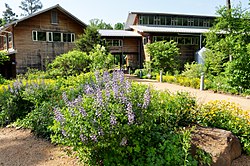| North Carolina Botanical Garden | |
|---|---|
 | |
 | |
| Location | Chapel Hill, North Carolina |
| Area | 700 acres (1.1 sq mi; 2.8 km2) |
| Opened | 1951 |
| Species | 2,500 |
| Website | ncbg |
The North Carolina Botanical Garden is a botanical garden operated by the University of North Carolina at Chapel Hill in Chapel Hill, North Carolina. The primary goal of the Garden is to research, catalog, and promote the native plant species of North Carolina.

